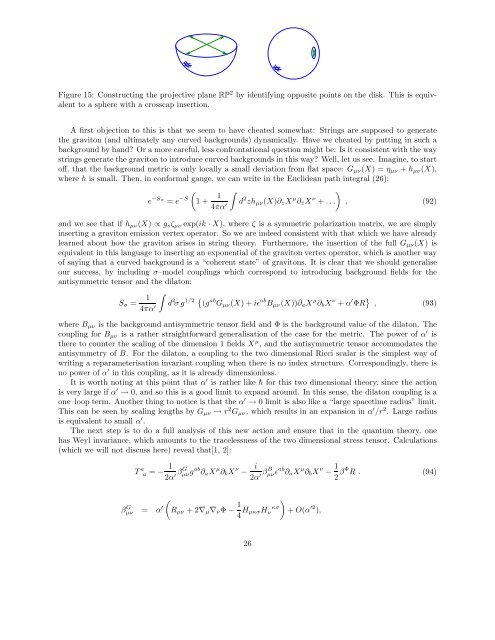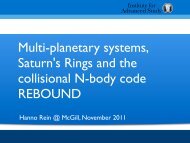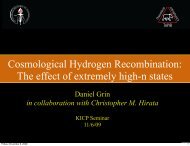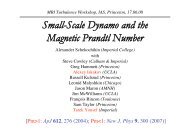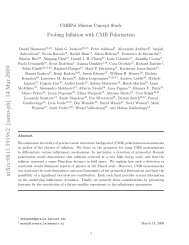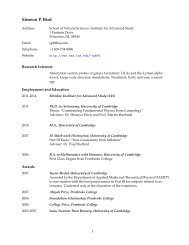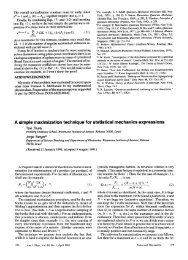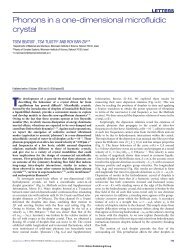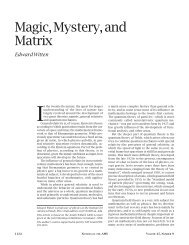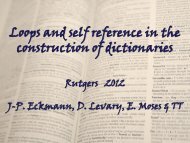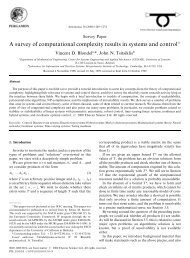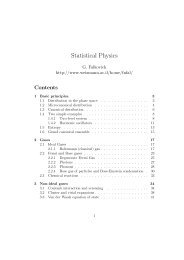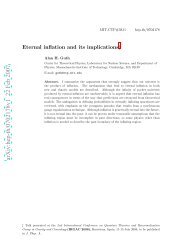Introduction to String Theory and D–Branes - School of Natural ...
Introduction to String Theory and D–Branes - School of Natural ...
Introduction to String Theory and D–Branes - School of Natural ...
You also want an ePaper? Increase the reach of your titles
YUMPU automatically turns print PDFs into web optimized ePapers that Google loves.
Figure 15: Constructing the projective plane RP 2 by identifying opposite points on the disk. This is equivalent<br />
<strong>to</strong> a sphere with a crosscap insertion.<br />
A first objection <strong>to</strong> this is that we seem <strong>to</strong> have cheated somewhat: <strong>String</strong>s are supposed <strong>to</strong> generate<br />
the gravi<strong>to</strong>n (<strong>and</strong> ultimately any curved backgrounds) dynamically. Have we cheated by putting in such a<br />
background by h<strong>and</strong>? Or a more careful, less confrontational question might be: Is it consistent with the way<br />
strings generate the gravi<strong>to</strong>n <strong>to</strong> introduce curved backgrounds in this way? Well, let us see. Imagine, <strong>to</strong> start<br />
<strong>of</strong>f, that the background metric is only locally a small deviation from flat space: Gµν(X) = ηµν + hµν(X),<br />
where h is small. Then, in conformal gauge, we can write in the Euclidean path integral (26):<br />
e −Sσ = e −S<br />
<br />
1 + 1<br />
4πα ′<br />
<br />
d 2 zhµν(X)∂zX µ ∂¯zX ν <br />
+ . . . , (92)<br />
<strong>and</strong> we see that if hµν(X) ∝ gsζµν exp(ik · X), where ζ is a symmetric polarization matrix, we are simply<br />
inserting a gravi<strong>to</strong>n emission vertex opera<strong>to</strong>r. So we are indeed consistent with that which we have already<br />
learned about how the gravi<strong>to</strong>n arises in string theory. Furthermore, the insertion <strong>of</strong> the full Gµν(X) is<br />
equivalent in this language <strong>to</strong> inserting an exponential <strong>of</strong> the gravi<strong>to</strong>n vertex opera<strong>to</strong>r, which is another way<br />
<strong>of</strong> saying that a curved background is a “coherent state” <strong>of</strong> gravi<strong>to</strong>ns. It is clear that we should generalise<br />
our success, by including σ–model couplings which correspond <strong>to</strong> introducing background fields for the<br />
antisymmetric tensor <strong>and</strong> the dila<strong>to</strong>n:<br />
Sσ = 1<br />
4πα ′<br />
<br />
d 2 σ g 1/2 (g ab Gµν(X) + iɛ ab Bµν(X))∂aX µ ∂bX ν + α ′ ΦR , (93)<br />
where Bµν is the background antisymmetric tensor field <strong>and</strong> Φ is the background value <strong>of</strong> the dila<strong>to</strong>n. The<br />
coupling for Bµν is a rather straightforward generalisation <strong>of</strong> the case for the metric. The power <strong>of</strong> α ′ is<br />
there <strong>to</strong> counter the scaling <strong>of</strong> the dimension 1 fields X µ , <strong>and</strong> the antisymmetric tensor accommodates the<br />
antisymmetry <strong>of</strong> B. For the dila<strong>to</strong>n, a coupling <strong>to</strong> the two dimensional Ricci scalar is the simplest way <strong>of</strong><br />
writing a reparameterisation invariant coupling when there is no index structure. Correspondingly, there is<br />
no power <strong>of</strong> α ′ in this coupling, as it is already dimensionless.<br />
It is worth noting at this point that α ′ is rather like ¯h for this two dimensional theory, since the action<br />
is very large if α ′ → 0, <strong>and</strong> so this is a good limit <strong>to</strong> exp<strong>and</strong> around. In this sense, the dila<strong>to</strong>n coupling is a<br />
one–loop term. Another thing <strong>to</strong> notice is that the α ′ → 0 limit is also like a “large spacetime radius” limit.<br />
This can be seen by scaling lengths by Gµν → r 2 Gµν, which results in an expansion in α ′ /r 2 . Large radius<br />
is equivalent <strong>to</strong> small α ′ .<br />
The next step is <strong>to</strong> do a full analysis <strong>of</strong> this new action <strong>and</strong> ensure that in the quantum theory, one<br />
has Weyl invariance, which amounts <strong>to</strong> the tracelessness <strong>of</strong> the two dimensional stress tensor. Calculations<br />
(which we will not discuss here) reveal that[1, 2]:<br />
T a a = − 1<br />
2α ′ βG µνg ab ∂aX µ ∂bX ν − i<br />
2α ′ βB µνɛ ab ∂aX µ ∂bX ν − 1<br />
2 βΦ R . (94)<br />
β G µν = α ′<br />
<br />
Rµν + 2∇µ∇νΦ − 1 κσ<br />
HµκσHν 4<br />
26<br />
<br />
+ O(α ′2 ),


